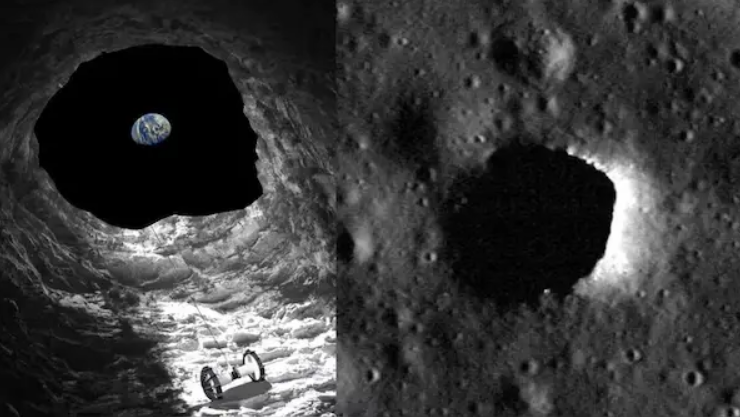A hidden cave on the moon has the potential to serve as a protected haven for future lunar explorers.
An undiscovered large natural popular cave located in the inner part of moon also came out on surface which is another excellent area where the creators of the future lunar space station can create a base. Mare Tranquillititas, the area appears to the entrance to the caves seen through an opening in what has become an ancient lava plain with Sea of Tranquility carved into its surface. The data of the Mare Tranquillitatis pit that NASA was able to get from the Lunar Reconnaissance Orbiter unveiled that the lunar hole, the deepest known lunar pit at the time of the publication, is 50 meters wide and up to 80 meters long; this means an area equivalent to 14 tennis courts. It currently stays at roughly 150 meters under the surface of the Earth.
The second source that reported information about the cave is the University of Trento in Italy’s Lorenzo Bruzzone; He explained that the cave could have been ‘probably an empty lava tube,’ and such characteristics may serve as a permanent residence to man when it offers a ‘natural shelter against the adverse lunar environment. ’The holes on the moon were discovered by orbiters much earlier than today’s moon rovers and probably over a decade ago.
Most are thought to be ‘sky light’ passage ways to underground chamber including Lava tubes which are large tubes formed for volcanic activities. As the temperature is relatively constant, these sorts of large caves may be used as the framework of a moonbase or as safe haven for the astronauts on the moon from deadly cosmic rays, extreme ultraviolet radiation and meteorites. Earlier, more photos taken by the LRO indicated there were boulders up to 10 meters in diameter at the base of the pit in the Mare Tranquillitatis.
However, it was still uncertain whether the hole was just a hole or if the bats actually use the cavity as an entrance to some underground cave, such as a lava tube with a ceiling collapse.
The scientists explain how they used the LRO data, together with the computer modeling to establish that this is a 100-metre wide pit that has vertical or overhanging walls, with a form of slope on the floor and the existence of a cave that extends to tens of meters in the westward direction. Rock formed in such a cave is therefore of great interest and interest to researchers as they may hold records of the formation of the moon and its volcanism. Regarding the presence of water ice, Bruzone pointed out that the caverns may have it and said that ice was an important factor when considering lunar exploration and living on the moon.
As of now, there are at least 200 Pit features identified on the moon, which are primarily distributed on the lava regions and may have become the openings of massive lava tubes. “Caves are advantageous in the sense that they provide access to the primary skeletal components of a potential habitation in the event that complex construction processes are unattainable,” noted Carrer, who is the first author of the study.
Currently, space agencies are contemplating the possibility of exploring the sciences used in analyzing the structural integrity of caves and reinforcing their walls and ceilings for the anticipation of human visitation on the moon. Habitats may also need to have monitoring devices, such as motion detectors or instruments that feel the ground for earthquakes, to inform the astronauts of when certain parts of the cave start to move in a way that warrants evacuating from the safest areas of the other habitats.
“Lunar cave systems have been suggested as the ideal area to establish future crewed facilities due to the thick layer of rock above the caves, which shields people and equipment from the extreme temperature difference between night and day temperatures on the moon’s surface and also from high energy radiation prevalent in the lunar environment,” Kathierine Joy, a professor of geoscientists in the University of Manchester. “But we are at the present time rather bereft of detailed information about the sub-surface structures that lie beneath such pit openings. ”As observed by a researcher at Arizona State University named Robert Wagner, availability shall be one of the major challenges. “To get to that pit we have to dig down 125m before reaching the floor; the rim is therefore a sloping surface of loose soil which,if shifted will cause small slides down an already prone target,”
he told us. Linn: “Yes, it’s a feasible strategy to do ‘get in and out,’ though it will require fairly much of infrastructure. ”
Do not forget to share your opinion with us to provide you with the best posts !




0 Comments